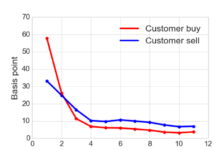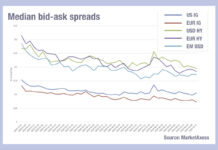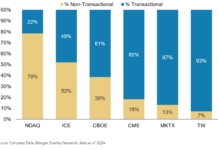By Frank Cerveny, Head of Markets and Sales at MTS.
How can institutional investors find the liquidity to grow their fixed income businesses with the limited resources and budgets at their disposal?
 Electronification is changing the face of fixed income markets in Europe and the US. Electronic trading volumes continue to rise rapidly year-on-year, and the trend is only continuing as regulatory and market developments pull participants away from voice trading and towards e-trading’s improved transparency, better data quality, reduced costs and tighter dealing spreads.
Electronification is changing the face of fixed income markets in Europe and the US. Electronic trading volumes continue to rise rapidly year-on-year, and the trend is only continuing as regulatory and market developments pull participants away from voice trading and towards e-trading’s improved transparency, better data quality, reduced costs and tighter dealing spreads.
Institutional investors now have more options than ever before in terms of execution venues, trading protocols, algos and utilities. However, the cost, time and difficulty in connecting technologies to existing OMS and EMS providers is holding the buy side back from accessing the liquidity they require.
A market in flux
The evolution of the bond markets has been both rapid and dramatic in recent years. Government monetary policy and a prolonged period of low interest rates have encouraged borrowers to issue record amounts of debt, increasing the number of bonds in circulation, particularly in the credit markets. The huge volume of bonds being issued by companies taking advantage of favourable market conditions have multiple maturities, currencies and structures, causing continued fragmentation in the market.
Meanwhile, post-crisis regulatory reform in Europe and the US has increased the cost of doing business for banks, with rules that require them to hold more collateral on their balance sheets driving many banks to reduce their fixed income market making activities and the number of client enquiries to which they will respond.
A number of non-banks are filling the hole left by the banks and starting to move into the business of making prices in fixed income, but investors are now faced with the complex challenge of finding out which of these institutions hold the bonds they are seeking to trade.
In response, forward-thinking fixed income technology vendors have developed innovative new trading protocols and tools to enable the buy side to discover and execute against this liquidity directly and efficiently. According to GreySpark Partners, over 40 new electronic trading platforms for corporate bonds alone have been launched since 2007, presenting a unique challenge to bond market participants.
Paradoxically, the vast array of new electronic trading platforms that have been launched has compounded fragmentation in the market, as the cost and time of connecting existing OMSs and EMSs to each of these trading venues has proved prohibitive at a time when desktop real estate is limited and budgets are tight.
Whereas previously buy-side firms may have looked to the sponsored access model to gain entry to these markets, the slow decline in banks’ prime broking activities has forced these firms to seek access to fixed income liquidity directly – but connecting to multiple platforms with their own integration and deployment complexities is often not a viable option due to technology and budget constraints.
As a result, ease and cost of deployment is now front of mind when buy-side firms are seeking trading venues that they can add to their existing OMS or EMS. In particular they are looking to innovative all-to-all trading protocols that enable them to connect with all types of participants on a single platform. Access to pre-trade information is also key, allowing firms to discover which counterparties hold the inventory of bonds they wish to trade.
By leveraging cost-effective, easily deployed technology that connects participants in the US, Europe and beyond, the fixed income market can reverse the tide of liquidity fragmentation and improve efficiency for all.
Tackling connectivity head-on
MTS has been a pioneer of electronic fixed income markets since 1988, and optimising liquidity by equipping traders with the technology and market data they require has always been central to our strategy. Understanding the integral role the buy side plays in fostering bond market liquidity, we have always ensured the majority of our technology is available to both banks and the investor community.
We pride ourselves on supporting customers to comply with new and emerging regulations. With the introduction of MiFID II in January 2018, both sell- and buy-side participants can be confident they are trading on a fully compliant MTF that delivers automated reporting capabilities to reduce the burden on their time and efficiency.
At MTS we recognise that connectivity is perhaps the most pressing challenge facing the buy-side – both to execution venues and directly to counterparties holding bonds they wish to trade.
To connect all types of counterparties with each other on a single venue, we have pioneered the all-to-all model on our MTS BondsPro platform. Liquidity is boosted by enabling all participants to act as either price provider, price taker or both.
The platform supports live, all-to-all trading for corporate bonds and emerging market debt, connecting a network of almost 900 buy-side and sell-side participants in the US, UK and Switzerland. This cross-border liquidity including all participants is key to fostering liquidity between the global bond markets.
MTS BondsPro offers a wide range of direct connectivity options – all with straight through processing – including API and web-based solutions, which are designed to bypass the need for software installation, to suit the diverse technology and budget requirements of buy-side firms.
Most recently we have partnered with Bloomberg to enable buy-side traders using Bloomberg’s EMS solution – TSOX – to trade in the MTS BondsPro liquidity pool directly from their Bloomberg terminal.
This is the first direct access trading connection by an unaffiliated electronic platform with Bloomberg TSOX and is a significant development for the buy side, delivering access to a new global liquidity pool without any additional desktop real-estate requirements or integration costs.
Connectivity is also a key tenet of our MTS BondVision platform, which offers buy-side firms cross-border access to European corporate and government bond markets. MTS BondVision is delivered via web or VPN, while API and FIX protocols support integration with firms’ existing OMS.
To aid investors in locating the counterparties holding the bonds they want to trade, we have developed a unique pre-trade information tool which allows clients to identify the banks that hold the bonds and then trade with them on MTS BondVision.
This offers firms an unparalleled level of pre-trade information and allows them to access bond inventories from a network of over 20 banks. Therefore the technology gives a comprehensive overview of real-time market liquidity on up to 20,000 axes daily, enabling buy-side members to locate an appropriate counterparty efficiently.
Very few firms have the budget and resources to develop systems that give them this comprehensive view of the market and allow them to leverage latent liquidity by connecting them to the relevant counterparties.
Aggregating data from execution venues is another key challenge facing the buy side. Informed trading and management decisions rely on access to optimal market data, but this can often be difficult to extract from electronic trading platforms and integrate with existing systems and processes.
Traders on MTS BondVision have access to real-time pricing across the European government bond market via MTS Cash, the largest interdealer market for fixed income rates products in Europe.
MTS is now rolling out dealer to client Repo functionality. Post-trade connectivity on MTS is also hassle free: MTS is linked to all the major European clearing houses and central securities depositories, and trade settlement instructions are automatically created and sent in real-time to the relevant central counterparties or CSDs/ICSDs on behalf of market participants.
A better connected future
Fast, cost-effective and straightforward connectivity to an electronic trading platform that offers access to a diverse pool of counterparties is crucial to enable buy-side firms to grow their fixed income businesses and to foster liquidity in the bond market as a whole.
In a market environment that is characterised by change and evolution – whether it be regulatory, structural or budgetary – the responsibility lies with technology vendors and electronic market operators to respond to this unique set of challenges with agile, innovative solutions. The platforms that will stand the test of time will be those that offer the perfect mix of light-touch, cost-effective technology, pre-trade information and cross-border access to deep pools of fixed income liquidity.

About the author: As Head of Markets and Sales at MTS, Frank Cerveny is strategic advisor to the CEO and responsible for growing the company’s interdealer and dealer-to-client electronic fixed income markets. Prior to joining MTS, Frank held the role of Managing Director and Co-Head of the International Credit Business at Jefferies International, where he was responsible for its fixed income trading, research and sales. Frank began his career as a trader at Salomon Brothers in New York and went on to spend nearly twenty years at Credit Suisse in London. At CS, Frank ran European Credit Sales, served on the Credit Operating Committee and was a trustee of the Credit Suisse EMEA Foundation. Frank holds an AB from Dartmouth College and an MBA from Harvard Business School.
TOP OF PAGE























